Home // Body Procedures // Fat Transfer/Grafting
Fat Transfer/Grafting Procedure in Franklin & Nashville TN
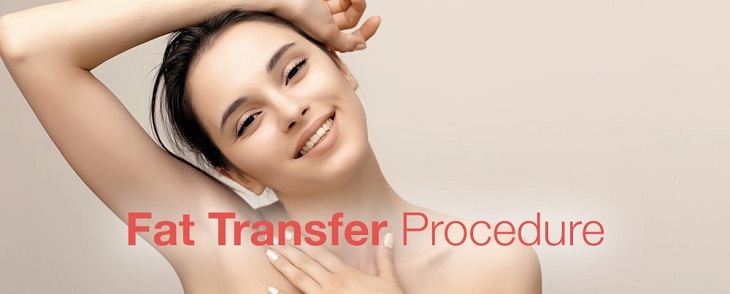
Although fat may be undesirable in some areas of the body, in other areas such as the face and buttocks, it can help a patient achieve a more youthful appearance. With fat grafting, Dr. Brought can remove fatty tissue from one area of the body and transfer it someplace else that will benefit from natural-looking volume, such as the hands, face, breasts, or buttocks.
As we age, our body produces less collagen and hyaluronic acid. These chemicals are important substances that increase skin cell turnover and keep skin firm, elastic and wrinkle-free. When the body slows production of these chemicals, signs of aging appear. These may include lines around the eyes, forehead, nose, and mouth. You may also notice that your skin appears hollow in certain places, perhaps near your eyes or cheeks. Fat grafts can be used as permanent fillers to correct these signs of aging using tissue from your own body.
The fat transfer procedure involves harvesting excess fat from one area of the body and then transferring into other areas of the body. Liposuction is performed under local or general anesthesia, usually as an outpatient procedure, and the harvested fat is purified before being injected back into the areas of the body requiring augmentation. When performed by a board-certified plastic surgeon, such as Dr. Brought, this procedure is safe and long-lasting.

Common fat grafting procedures include the augmentation of:
- Lips: Fat is harvested and injected into different areas of the lips, resulting in increased volume and decreased lines and wrinkles.
- Cheeks: Fat is transferred to the hollows in the cheeks resulting in a more rounded and youthful facial profile.
- Buttocks: Also known as a "Brazilian" butt lift. Fat is harvested from one area of the body or buttocks and injected into the area of the buttocks requiring a rounder, fuller appearance or a more shapely silhouette.
- Breasts: Harvested fat is used to shape breasts after breast enlargement, reconstruction and to round out the appearance of breast implants.
- Hands: Harvested fat is injected on the tops of hands to reduce the appearance of veins and tendons to give hands a more youthful appearance.
What to Expect With a Fat Grafting Procedure
Fat grafting is a fitting option for those who have areas of the body with excess fat and other areas that have the need for shaping or filling. This procedure offers a more permanent correction of these areas than is provided by temporary fillers. It can improve your body contour, fill in bodily depression and rejuvenate the appearance of the face and hands.
While fat grafting will give you a more youthful appearance, there are certain things that it can not do:
- Tighten skin
- Smooth skin that is excessively loose or slack
- Remove age spots
- Eliminate fine lines and wrinkles from sun damage or age
- Take the place of more advanced procedures such as a facelift
The fat grafting procedure is typically done in a single outpatient procedure, although subsequent fat injections are sometimes needed to achieve optimal results. The procedure typically takes anywhere from 30-120 minutes, depending on the number and volume of areas to be augmented and what, if any, other procedures the patient is having done at the same time. Fat grafting is sometimes done to supplement the results of other procedures such as a facelift or breast implant augmentation.
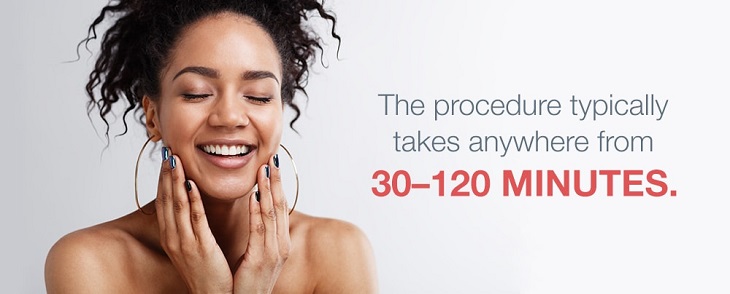
Schedule A Fat Grafting Consultation Today
Benefits of Fat Grafting Surgery
There are many benefits of fat grafting surgery.
- A more youthful-looking appearance due to the reduction of the appearance of lines, skin depressions and indentations.
- The transfer of fat from another area of the body where you don't want it into an area where it will benefit.
- The use of tissue from your own body eliminates the use of synthetic fillers and the risk of allergies.
- May eliminate the need for repeated cosmetic procedures, is longer lasting and more economical in the long run.
- Less invasive than other facial procedures, with minimal downtime depending on the area of the body and number of procedures being done.
- Offers improved skin appearance over other fillers due to its having a rich source of stem cells.
Interested in having a Fat Transfer Procedure in Nashville, Tenn.? Schedule a consultation with Dr. Brought today.
How Fat Grafting Works
Fat grafting requires fat to be harvested from the body, washed and purified and then re-injected into the body using special needles. The process is performed in several steps:
- Anesthesia: Depending on the extent of the procedure, you will receive either local or general anesthesia
- Incision: Tiny, inconspicuous incisions are made in the areas from which fat will be harvested. Dr. Brought will close these incisions with stitches that will be absorbed by the body.
- Liposuction: Diluted local anesthesia is infused to reduce trauma, postoperative pain and bleeding. In order to remove the fat layer underneath the skin, a cannula is inserted and used to suction out the fat cells. Dr. Brought will push and pull the cannula through the fat layer as necessary in order to break up the fat cells and suction them out.
- Purification: Once enough fat is harvested, Dr. Brought will prepare the fat cells for syringes used for fat injection. The harvested fat is filtered to remove impurities.
- Placement: The area that will receive the transfer will be prepared and the harvested fat injected via a syringe. The number of injections is determined by the area being injected and the volume of fat that is required to fill it.
Common areas from which to take fat include:
- Thighs
- Buttocks
- Waist
- Abdomen
- Lower back
- Upper back
- Upper arms
- Any place on the body with a little extra fullness
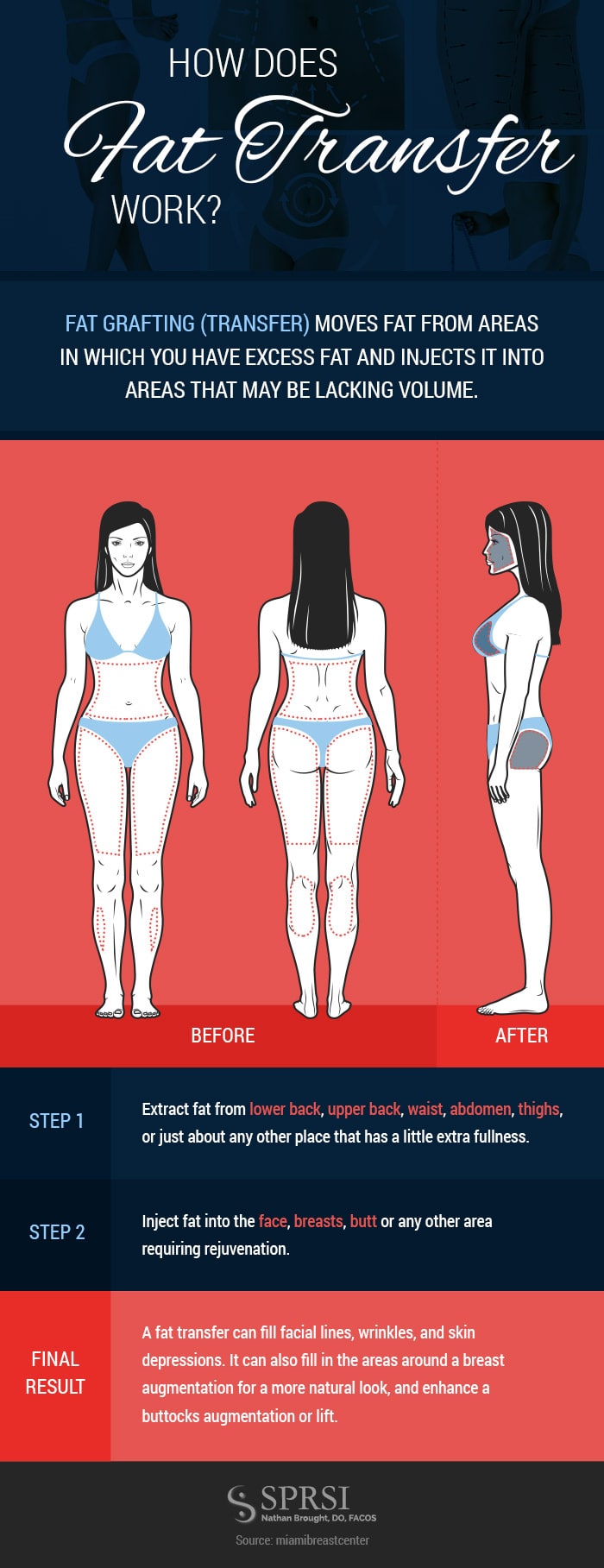
Risks of Fat Grafting
The decision to have fat grafting is one that should be made carefully after learning about all of the benefits and risks along with the potential outcome of the procedure. Although no surgery is entirely risk-free, fat grafting is a safe procedure for ideal candidates. While side effects and complications are uncommon, they can include:
- Scarring
- Infections
- Hematomas
- Bleeding
- Reaction to anesthesia
- Contour irregularities or asymmetry
Although fat transfer risks are rare, they can be minimized by working with a board-certified, experienced plastic surgeon. Your doctor will discuss the risks and benefits with you and provide you with all the information you need to make an informed decision.
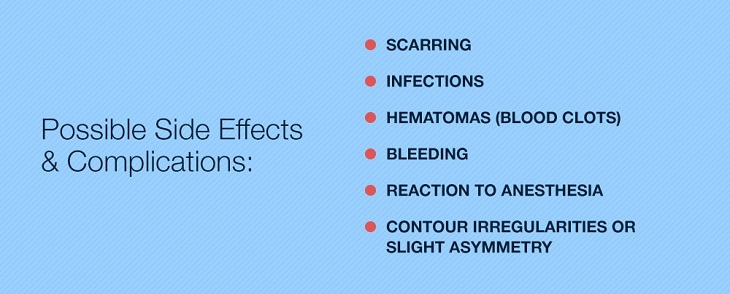
If you live near Franklin, Tenn., schedule a consultation with our board-certified plastic surgeon, Dr. Brought.
Schedule A Fat Grafting Consultation TodayPreparing for a Fat Grafting Procedure
Steps to take before surgery include:
You should also be willing to follow the post-procedure instructions, which may include restricting activity for a period of time or limiting sun exposure. For the best possible results, you should also be willing to live a healthy lifestyle. That includes using sun protection, practicing sound nutrition habits and getting regular exercise.
- Avoiding alcohol, aspirin and blood thinning medications for at least 14 days before the procedure.
- Disclosing your health history and any current medications, vitamins and herbal supplements that you are taking with your plastic surgeon.
- Getting lab work or a medical evaluation.
- Staying hydrated.
- Communicating effectively with your surgeon about the procedure, your expectations, and the risks and benefits.
- Making arrangements to take enough time off of work or school for recovery.
- Arranging for help and support for the first few days after surgery.
Ideal Candidates for the Procedure
You may be an ideal candidate for a fat grafting procedure if you are:
- In good overall health
- Have realistic expectations of surgery outcome
- A non-smoker
- Willing to follow post-operative instructions such as restricting activity and limiting sun exposure.
- Someone who lives a healthy lifestyle including the use of sun protection, good nutrition habits and regular exercise.
- Someone who has areas of the body with available donor fat and other areas that are deficient in volume.
Fat transfer may not be a safe option for those with conditions such as:
- Blood clotting problems
- Uncontrolled high blood pressure
- Circulation problems
- Smoking
- Past silicone injections
- Recent filler injections or previous surgery
Fat Injections vs. Other Dermal Fillers
Natural Permanent Fillers
Fat Injections
Harvested fat has the potential to be permanent although it may not stay in its new location for a long period of time. For any fat transfer procedure, anything from 20 percent to 90 percent of the fat augmentation may become permanent. Transferred fat may also calcify, absorb into the body, cause scarring or become a cyst. This is especially common in breasts. However, there are many benefits including:
- Safe, natural, and soft
- No allergic reaction
- May be best for the most natural-looking results.
- Effective in many areas of the body including lips, cheeks, breasts, buttocks and hands.
- Not as readily available as synthetic dermal fillers.
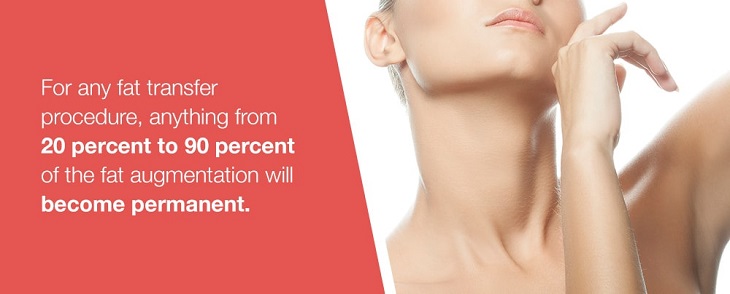
Synthetic Permanent Fillers
- ArteFill: Alternative for those patients who don't want the time and expense involved with fat transfer.
- Polyacrylamide gels: Not yet FDA-approved in the U.S. Produce natural results and are permanent, safe and removable.
- Polyvinyl alcohol-based gels: Not yet approved in the U.S. Safety has not been proven.
Synthetic permanent fillers have many benefits including:
- Work best to fill small, tight areas.
- Stiffer consistency than fat.
- May be more readily available than fat injections.
Synthetic Temporary Fillers
- Collagen-based products: Last from six weeks to three months.
- Hyaluronic acid derivatives: Last from three months to well over a year.
Synthetic temporary fillers have similar benefits to synthetic permanent fillers.
- Works best to fill small, tight areas.
- Stiffer consistency than fat.
- May be more readily available than fat injections.
Factors to Consider
Being informed and prepared will greatly help you decide if the fat transfer procedure is right for you. There are a few important things to know and factors to consider when deciding to have this procedure done.
Recovery Time
Since fat grafting requires a short surgical procedure, including liposuction, as opposed to an injection, the recovery time is a little longer. You will need to have someone drive you home and stay with you for at least the first 24 hours after the procedure. Since postoperative swelling may last for several weeks, you may not be ready to go out in public right away. You may need to take between one and a few weeks off of work for recovery time.
Cost
Fat transfer cost depends on the amount of intervention and whether or not the transfer is accompanying another cosmetic procedure. The national average for fat grafting is $4,600, with a range of $2,000 to $7,000. Although the cost of your fat transfer depends on your consultation with Dr. Brought, you can estimate your procedure to cost near the national average.
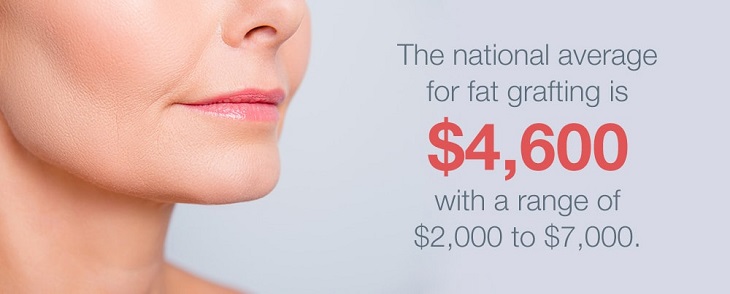
Dr. Nathan Brought serves patients in the Franklin, Nashville, Memphis, Knoxville, and Chattanooga, TN region. For more information about fat grafting, or to schedule a consultation with Dr. Brought, contact SPRSI.
Although different for every patient, costs that may be incurred include:
- Surgeon's fees
- Surgical center or hospital fees
- Fees for pain medications
- Anesthesia fees
Changes in Body Appearance
It may take a little while to get used to the changes after your fat transfer procedure. It may take several weeks for the swelling, lumps and bruising to disappear to see the full results. Fat grafting is a procedure with long-lasting results, so it's important to be aware of this before having it done. You should expect to feel emotional as you adjust to your new appearance. Most fat transfer patients enjoy a greater sense of confidence and a more positive body image after they have recovered and achieved full results.
Recovery Tips
After your surgery, common postoperative symptoms include:
- Drainage from your incision site(s).
- Swelling at both the injection and donor sites for several weeks after surgery.
- Bruising that usually takes from two weeks to a month to completely fade.
- Numbness
- Asymmetry
- While pain should be limited, you may need pain medication during the first few days to ease discomfort.
Tips for having a full recovery:
- Follow all post-operative instructions exactly.
- Sleep with your head slightly elevated (above your heart) for 10-14 days after surgery of the head and neck areas.
- Keep activities to a minimum and avoid strenuous activities for at least seven to 10 days after surgery.
- Keep incision sites clean.
- Avoid steam baths and saunas for at least six weeks after surgery.
- Avoid aspirin and alcohol for the 14 days before and after your surgery.
- Avoid sun exposure on surgical sites.
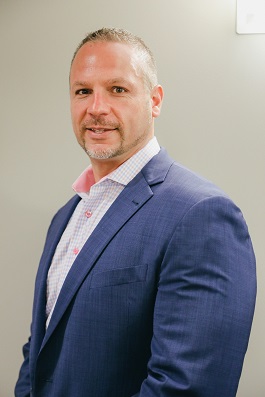
FAQs
Just in case you have a question about an area we haven't covered yet, here are the answers to some frequently asked questions about fat transfer procedures.
Q: Where will my fat transfer procedure take place?
A: Your fat grafting procedure may be performed in an accredited hospital, a free-standing ambulatory facility or an office-based surgical suite. It is usually performed as an outpatient procedure with most patients sent home the same day after a short observation period.
Q: Is the fat transfer procedure painful?
A: While the pain associated with the procedure is usually mild, you will experience some short-term discomfort afterward which should be easily managed by oral pain medications. Speak with your doctor about any considerable pain or concerns about pain management.
Q: Why should I choose fat injections over other dermal fillers?
A: Fat injections may provide the safest and most natural-looking results. Since synthetic fillers contain substances that your body's immune system can reject, there is a much greater chance of having an adverse reaction. Using the body's own natural tissue eliminates the chance of an allergic or adverse immune reaction.
Q: How do I choose the right surgeon for my fat transfer procedure?
A: Be sure to choose a board-certified plastic surgeon, who has extensive experience in fat transfer procedures with positive results and with whom you feel comfortable. The American Society for Aesthetic Plastic Surgery (ASAPS) has provided a list of questions you can use to help choose a plastic surgeon who is right for you.
Contact us Today
Dr. Nathan Brought serves patients in the Franklin, Nashville, Memphis, Knoxville and Chattanooga, Tenn. region. For more information about fat grafting, or to schedule a consultation with Dr. Brought, contact SPRSI.
Information on Other Body Procedures
- Abdominoplasty/Tummy Tuck
- Weight Loss Surgery
- Panniculectomy
- Thigh Lift
- Liposuction
- Labiaplasty
- Buttocks Augmentation
- Arm Lift
- Mommy Makeover Surgery
*Updated June 19th, 2017
View Our Before/After Gallery Schedule A Fat Grafting Consultation Today

